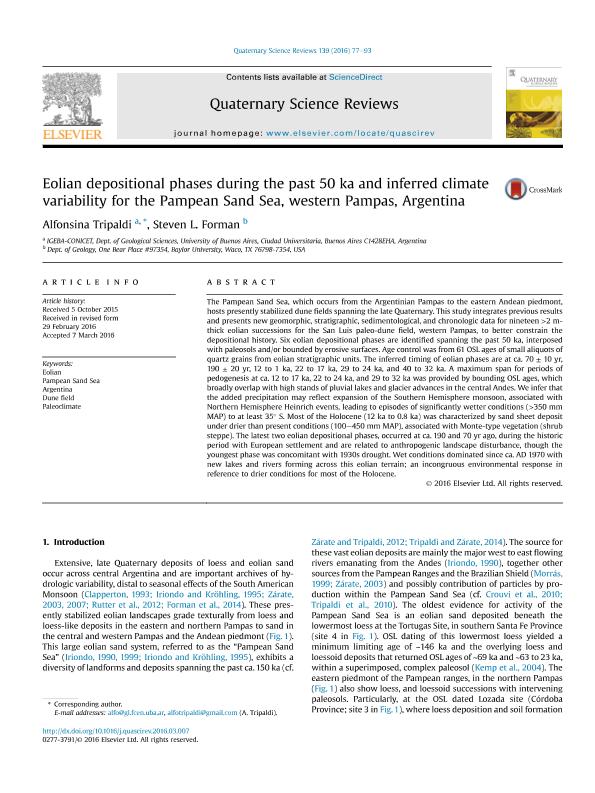Mostrar el registro sencillo del ítem
dc.contributor.author
Tripaldi, Alfonsina

dc.contributor.author
Forman, Steven L.
dc.date.available
2017-07-10T20:18:21Z
dc.date.issued
2016-03
dc.identifier.citation
Tripaldi, Alfonsina; Forman, Steven L.; Eolian depositional phases during the past 50 ka and inferred climate variability for the Pampean Sand Sea, western Pampas, Argentina; Elsevier; Quaternary Science Reviews; 139; 3-2016; 77-93
dc.identifier.issn
0277-3791
dc.identifier.uri
http://hdl.handle.net/11336/20041
dc.description.abstract
The Pampean Sand Sea, which occurs from the Argentinian Pampas to the eastern Andean piedmont, hosts presently stabilized dune fields spanning the late Quaternary. This study integrates previous results and presents new geomorphic, stratigraphic, sedimentological, and chronologic data for nineteen >2 m-thick eolian successions for the San Luis paleo-dune field, western Pampas, to better constrain the depositional history. Six eolian depositional phases are identified spanning the past 50 ka, interposed with paleosols and/or bounded by erosive surfaces. Age control was from 61 OSL ages of small aliquots of quartz grains from eolian stratigraphic units. The inferred timing of eolian phases are at ca. 70 ± 10 yr, 190 ± 20 yr, 12 to 1 ka, 22 to 17 ka, 29 to 24 ka, and 40 to 32 ka. A maximum span for periods of pedogenesis at ca. 12 to 17 ka, 22 to 24 ka, and 29 to 32 ka was provided by bounding OSL ages, which broadly overlap with high stands of pluvial lakes and glacier advances in the central Andes. We infer that the added precipitation may reflect expansion of the Southern Hemisphere monsoon, associated with Northern Hemisphere Heinrich events, leading to episodes of significantly wetter conditions (>350 mm MAP) to at least 35° S. Most of the Holocene (12 ka to 0.8 ka) was characterized by sand sheet deposit under drier than present conditions (100–450 mm MAP), associated with Monte-type vegetation (shrub steppe). The latest two eolian depositional phases, occurred at ca. 190 and 70 yr ago, during the historic period with European settlement and are related to anthropogenic landscape disturbance, though the youngest phase was concomitant with 1930s drought. Wet conditions dominated since ca. AD 1970 with new lakes and rivers forming across this eolian terrain; an incongruous environmental response in reference to drier conditions for most of the Holocene.
dc.format
application/pdf
dc.language.iso
eng
dc.publisher
Elsevier

dc.rights
info:eu-repo/semantics/openAccess
dc.rights.uri
https://creativecommons.org/licenses/by-nc-nd/2.5/ar/
dc.subject
Eolian
dc.subject
Pampean Sand Sea
dc.subject
Argentina
dc.subject
Dune Field
dc.subject
Paleoclimate
dc.subject.classification
Geología

dc.subject.classification
Ciencias de la Tierra y relacionadas con el Medio Ambiente

dc.subject.classification
CIENCIAS NATURALES Y EXACTAS

dc.title
Eolian depositional phases during the past 50 ka and inferred climate variability for the Pampean Sand Sea, western Pampas, Argentina
dc.type
info:eu-repo/semantics/article
dc.type
info:ar-repo/semantics/artículo
dc.type
info:eu-repo/semantics/publishedVersion
dc.date.updated
2017-07-10T16:21:39Z
dc.journal.volume
139
dc.journal.pagination
77-93
dc.journal.pais
Países Bajos

dc.journal.ciudad
Amsterdam
dc.description.fil
Fil: Tripaldi, Alfonsina. Consejo Nacional de Investigaciones Científicas y Técnicas. Oficina de Coordinación Administrativa Ciudad Universitaria. Instituto de Geociencias Basicas, Aplicadas y Ambientales de Buenos Aires. Universidad de Buenos Aires. Facultad de Ciencias Exactas y Naturales. Instituto de Geociencias Basicas, Aplicadas y Ambientales de Buenos Aires; Argentina
dc.description.fil
Fil: Forman, Steven L.. Baylor University; Estados Unidos
dc.journal.title
Quaternary Science Reviews

dc.relation.alternativeid
info:eu-repo/semantics/altIdentifier/doi/http://dx.doi.org/10.1016/j.quascirev.2016.03.007
dc.relation.alternativeid
info:eu-repo/semantics/altIdentifier/url/http://www.sciencedirect.com/science/article/pii/S0277379116300683
Archivos asociados
